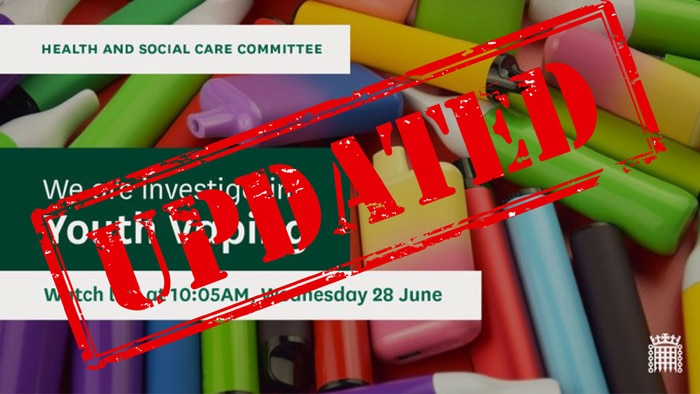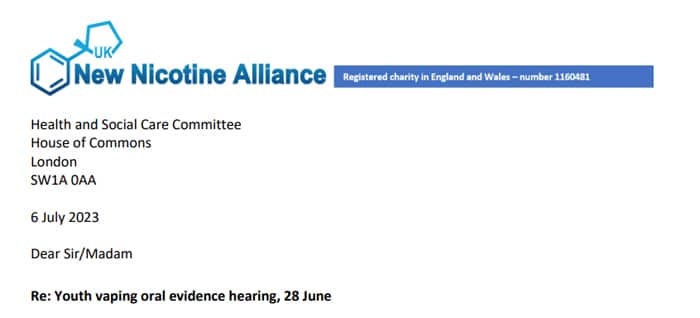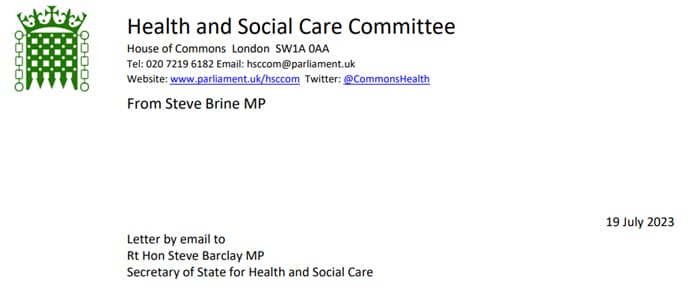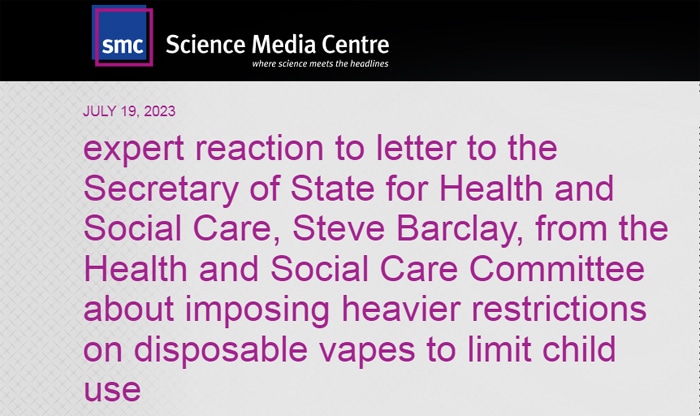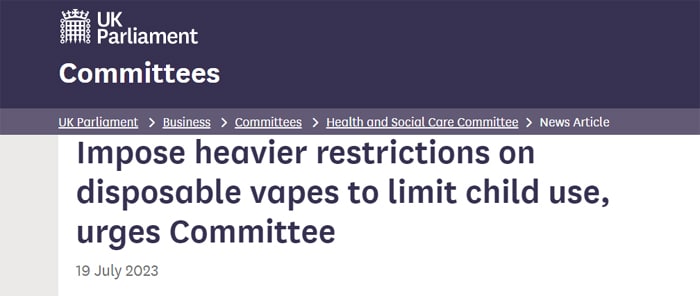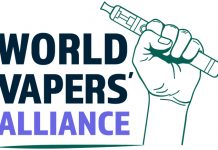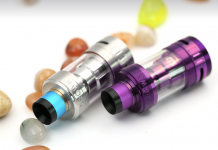On July 8th I wrote about the House of Commons Health and Social Care Committee held on Wednesday 28th of June discussing Youth Vaping. Well there have been some updates…
You should be able to watch the footage here on the Parliament TV page and you can also view the full transcript here in PDF Format.
Anyway it was full of misinformation – with even the old chestnuts about Popcorn Lung and Antifreeze in e-liquid being blurted out.
As a response the NNA (New Nicotine Alliance) produced a letter to the committee to point out all the inaccuracies that were presented as fact. You can read the letter here.
Report From Committee Chair
After the committee the Chair – Steve Brine MP – wrote a letter to Steve Barclay MP (the Secretary of State for Health and Social Care) detailing the findings from the committee.
The letter is 5 pages long, but I will try to summarise the main points below. You can also read the full letter here.
Note: Items in italics are their words – obvious misinformation!
He states that there is a rising trend in children vaping and says that existing measures to prevent under 18’s from accessing vapes is not working.
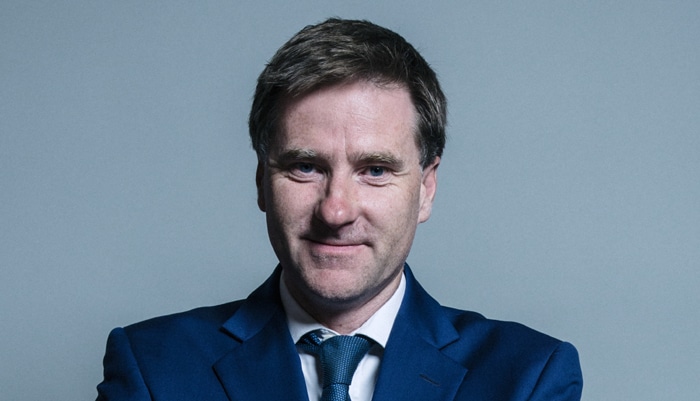
The comments from Laranya Caslin (Principal at St George’s Academy, Sleaford) about the effects of vaping on the pupils at her school are discussed and how the potential risks of long term vaping are not clear. There is also an issue of illegal vapes getting into the hands of under age vapers which apparently contained…
“very little nicotine”, with one containing only “hydraulic oil and antifreeze” amongst other “extremely concerning chemicals”
This was a great view though…
“We note concerns from both the health sector and industry about encouraging a black market in unregulated and illegal products by restricting legal vapes, potentially exposing children (and other users) to greater harm, which we return to below”
He feels the Government and Vaping Industry need to act to protect children from the “Harmful effects of vaping” but it needs to be balanced against the possibility of fuelling a Black Market in harmful non compliant vapes.
The topic of restrictions such as the heavy ones in Australia were discussed as Dr Helen Stewart was in favour of implementing a similar strategy in England. But there were counter arguments about blanket bans due to their role in smoking cessation and feeding the illicit market.
On this topic the letter says…
“We believe there is a need for the Government to consider much heavier restrictions on disposable vapes, in particular. It should approach the issue with caution, however, and be led by evidence in its decision-making, including that from Australia. We also believe that there are several more specific steps that the Government and industry could take to limit children’s access to vapes specifically, which are detailed below. “
Flavours, Packaging and Advertising Regulation
There were arguments for and against the role of flavours in vaping. Laranya commented on how some of the flavour names were pitched at a younger audience. Thankfully Deborah Arnott of ASH (Action on Smoking & Health UK) stuck up for flavours as they help smokers to transition away from tobacco.
The role of the vaping industry was questioned in regard of flavours and packaging designed to attract children. However it was acknowledged that the industry has taken some steps to prevent / discourage companies from using flavours specifically aimed at children and cartoon like packaging.
The letter says…
“The industry has not gone far enough in ensuring that its products do not appeal to a youth demographic. It is disingenuous for it to claim otherwise. Shops are able to display wide ranges of vapes in colourful, flavoured varieties, and in locations that do not usually sell similar products. We heard, for example, about vapes being sold in chicken shops and pound shops. This is in sharp contrast to tobacco products, which must be locked away and packaged in standardised plain packaging containing health warnings.”
“We recommend that the Government reviews restrictions on packaging and marketing of vapes, and that, to avoid their being advertised and marketed to children, it considers bringing the restrictions in line with those that apply to tobacco products. We would also welcome from the Department a summary of its plans for public health work around vaping, including resources aimed specifically at young people.”
Enforcement and the Role Of Trading Standards
The fact that there are already laws in place to prevent sale of vapes to under 18’s was covered but the other means of obtaining vapes outside of the regulated network is causing issues.
Industry representatives (John Dunne – UKVIA, Marcus Saxton IBVTA) believe that stronger enforcement is required. The low penalties for those breaking the laws were demonstrated and a need for a licence for retailers was discussed.
The recommendation in the letter is as follows…
“We agree that there is a need for much better enforcement of the law on not selling to under 18’s, and that trading standards should be well-placed to tackle non-compliant vendors. We do not, however, accept that this is the sole solution to preventing young people vaping. Trading standards is delivered by local authorities operating under substantial resource pressures. We recommend that the Government review whether trading standards has sufficient resources, and enforcement powers, to fulfil this vital role. We also believe its enforcement role would be made easier if it worked with the grain of the actions outlined above on packaging, advertising and flavouring regulation.”
Enforcement: Cost
The financial aspects of vaping were next in line and the fact that vapes are cheaper than tobacco products as they are not subject to the same rate of tax as tobacco. The industry representatives emphasised that this needs to be the case to keep vapes accessible to those on lower incomes and for it to be an incentive to quit expensive tobacco products.
However ASH are looking to add an Excise charge of £5 to disposable vapes as a deterrent to children. Also this means that vapes would be included in the HM Revenues and Customs (HMRC) system which would allow extra powers to prevent import and distribution of non regulated devices.
The letter concludes on this topic…
“It cannot be right that vapes are available for purchase for pocket money prices, making them an easy option for children to purchase, nor that they can be imported cheaply and legally on a large scale by third-party sellers. We recommend that OHID (Office for Health Improvement and Disparities)—and the Treasury—assess the proposal for an excise tax on disposable vapes, with a specific focus on the likely impact of vape use amongst children and lower income smokers.”
Closing Statement
The letter ends as below…
“We very much welcome OHID’s call for evidence on this topic. The causes and consequences of the increase in children and young people vaping may not become fully apparent for some time. It is encouraging that the Government is keen to understand and follow the evidence at this stage, and we hope that it will take seriously the suggestions made by our witnesses to help eliminate youth vaping entirely. We would appreciate a response to the recommendations outlined in bold above by 18 August.”
Expert Reactions To Steve Brine’s Letter
An article on the SMC (Science Media Centre) website was published on July 19th titled – “Expert reaction to letter to the Secretary of State for Health and Social Care, Steve Barclay, from the Health and Social Care Committee about imposing heavier restrictions on disposable vapes to limit child use“.
Three experts have published their response to the letter from Steve Brine to Steve Barclay.
Prof Lion Shahab, Professor of Health Psychology and Co-Director of the UCL Tobacco and Alcohol Research Group, UCL…
“The letter of the Health and Social Care Committee to the Secretary of State for Health and Social Care, published today, makes some very sensible suggestions following a recent evidence session on Youth Vaping. The key challenge for the government is to balance the benefits of e-cigarettes for helping smokers stop using the mostly deadly of products, cigarettes, with the potential risks they have for encouraging youth vaping. While e-cigarettes confer only a fraction of the harm of cigarettes, they are not risk free, which is of particular concern if their availability results in long-term use among youth who would have never smoked. Clearly, neither e-cigarettes nor cigarettes should be promoted to youth and reducing their appeal to kids is sensible. The letter calls for restrictions on packaging and marketing of vapes, akin to those that apply to tobacco products. However, the devil will be in the detail. Brightly coloured e cigarettes, flavours and ads with apparent youth appeal need to be restricted, but it is important that no regulatory equivalence is drawn with cigarettes. Cigarette use still kills 75,000 people each year in the UK, and e-cigarettes have helped drive down smoking rates in the adult population. Yet, recent negative press has meant that, even among smokers, nearly 60% now believe that – compared with cigarettes – e-cigarettes are as or more harmful, which may discourage switching to these harm reduction products. Further, while concerns about new disposable vapes (the likes of “Elfbar”) are justified, given the big increase in their use by youth, they are also adopted by smokers trying to quit cigarettes. A key policy therefore should be restricting access to these products to those who need them: smokers.
“The letter rightly calls for more resources and enforcement powers for trading standards to ensure that those selling adolescents age-restricted vapes are punished and for a review of proposals of a specific excise tax on disposable to make them less affordable. However, it will again be important to consider unintended consequences as cost (and flavour choice, for that matter) is an important driver for switching to e cigarettes for smokers as well. Studies in the United States show that flavour restrictions and tax increases imposed on e-cigarettes have the desired effect of reducing e-cigarette use but, unfortunately, also increase cigarette use. Finding a happy medium of regulations will not be easy but agreeing on the desirable outcome of any policy change should be: for adult smokers e-cigarettes ought to be more easily available (and appealing) than cigarettes, while adolescents should not be targeted by e-cigarette companies nor should underage youth be able to access e cigarettes (or any tobacco product) in retail outlets.”
Dr Sarah Jackson, Principal Research Fellow, UCL Tobacco and Alcohol Research Group, UCL…
“The rise in disposable vaping among young people is a cause for concern, and I welcome the call for tighter regulation. However, the approach will need to be carefully considered in order not to deter people who smoke from switching to vaping – or to trigger people to relapse back to smoking. For example, increasing the cost of disposable vapes in line with non disposable vapes would continue to offer a considerable cost saving for smokers (the average smoker in England spends approximately £20 on cigarettes each week), while making them less affordable for young people. However, restrictions on flavoured vapes could have unintended consequences, as flavours are an important part of the appeal for people who smoke.
“I echo ASH’s caution against an outright ban on disposable vapes: while it may seem like a simple solution, it risks driving demand toward an unregulated black market. We know that legal nicotine vapes pose a fraction of the risks of smoking cigarettes, but the risks of illegal vapes – which may contain banned ingredients or fail to meet safety standards – are unclear.”
Prof Nick Hopkinson, Professor of Respiratory Medicine, Imperial College London…
“The evidence is clear that e cigarettes are much safer than smoking and at least as effective as nicotine replacement therapy in people who are trying to quit smoking.
“We need to make sure that e cigarettes are available to help smokers while taking steps to stop children vaping.
“We know what worked to bring down youth smoking. We need to do the same things to make vaping less affordable and appealing to young people. A £5 excise tax on disposable vapes will mean they are no longer available for pocket money prices and bring them within the excise control regime so that HMRC and Border Force can work to stop illegal imports.
“The government voted against giving itself powers to control the marketing of vapes to children back in 2021, so we are playing catch up now and there is no time to lose.”
UK Parliament News Article
A news article was released on the UK Parliament website on 19th July discussing the findings of the committee. You can read it here – “Impose heavier restrictions on disposable vapes to limit child use, urges committee”.
In the article it says the following on the subject of Youth Vaping…
“The Committee believes that the Government can maintain a public health message on the potential value of vapes as a tool to help smokers to quit while ensuring that its messaging and education, enforcement and regulatory approach keeps them out of sight and reach of children.
The Committee is calling for the Government to:
1) Consider bringing restrictions on packaging and marketing of vapes in line with those that apply to tobacco products
2) Review resources and enforcement powers of trading standards to prevent vapes being sold to children
3) Assess the impact on use among children and smokers on lower incomes of a proposed excise tax on disposable vapes, which would also help to protect against imports of illegal products – which the Committee heard can contain chemicals including hydraulic oil and antifreeze”
The chair Steve Brine summed up his conclusion of the committee…
“Decisive action is needed now from both Government and industry to tackle an alarming trend in the number of children vaping and to protect them from its harmful effects.
“It’s clear to us that the vaping industry has not gone far enough to ensure that its products don’t appeal to children. When you have brightly coloured and branded vapes with flavours that name unicorns, sweets and popular fizzy drinks displayed in locations ranging from newsagents to chicken shops, it’s disingenuous for the industry to claim otherwise.
“We heard a wake-up call from a headteacher who told us that hydraulic oil and antifreeze, along with other extremely concerning chemicals, were found in a vape confiscated at her school.
“Ministers need to focus, across Government, on the impact vaping is having in our schools, whether that be setting off smoke alarms in toilets or restricting access to them entirely for young people. We’ve heard this issue is really impacting on the delivery of education in schools and, post-pandemic in particular, this is the last thing we can afford.”
What Is Next?
Well in the letter from Steve Brine to Steve Barclay it is requested that the government responds to the recommendations before 18th August 2023.
It is great to see some of the responses praising vaping and urging caution on regulation. The issue of youth vaping does need tackling but it needs to be well balanced to ensure adult smokers can access vaping products as easily as they can access tobacco.
So will we see a ban on disposables? Increased Taxes? Or just tighter regulations? Who knows…
Fingers crossed huh!
Related Tweets
expert reaction to letter to the Secretary of State for Health and Social Care, Steve Barclay, from the Health and Social Care Committee about imposing heavier restrictions on disposable vapes to limit child usehttps://t.co/GniNP840Vu
— Science Media Centre UK (@SMC_London) July 19, 2023
Prof Shahab:
“Studies in the United States show that flavour restrictions and tax increases imposed on e-cigarettes have the desired effect of reducing e-cigarette use but, unfortunately, also increase cigarette use.” https://t.co/egNY0A261m
— Jukka Kelovuori (@jkelovuori) July 19, 2023
👉” … restrictions on flavoured vapes could have unintended consequences, as flavours are an important part of the appeal for people who smoke.” https://t.co/3OjwzMH8tP
— IEVA (@europeanvaping) July 20, 2023
Expert reaction to letter to Health Sec. Steve Barclay, from the Health and Social Care Committee about imposing heavier restrictions on disposable vapes to limit child use with quotes from @LionShahab @DrSarahEJackson and @COPDdoc https://t.co/JgI00HNUDZ
— Sharon Cox (@Sharon_ACox) July 20, 2023
“Studies in the United States show that flavour restrictions and tax increases imposed on e-cigarettes have the desired effect of reducing e-cigarette use but, unfortunately, also increase cigarette use”https://t.co/MRIZJyEdfM
— European Tobacco Harm Reduction Advocates (@europethra) July 19, 2023
expert reaction to letter to the Secretary of State for Health and Social Care, Steve Barclay, from the Health and Social Care Committee about imposing heavier restrictions on disposable vapes to limit child use | Science Media Centre https://t.co/4g92GBfuWj
— Louise (@grannylouisa) July 19, 2023
